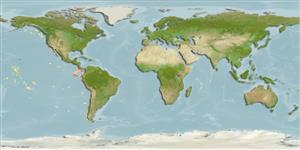Klassifizierung / Names
Namen | Synonyme | Catalog of Fishes(Gattung, Arten) | ITIS | CoL | WoRMS | Cloffa
>
Ophidiiformes (Cusk eels) >
Bythitidae (Livebearing brotulas)
Etymology: Pseudonus: Greek, pseudes = false + Greek, onos = hake.
More on author: Garman.
Environment: milieu / climate zone / depth range / distribution range
Ökologie
seewasser bathydemersal; tiefenbereich 915 - 1620 m (Ref. 34024). Deep-water
Eastern Central Pacific: Gulf of Panama, off Ecuador and northern Peru, Galapagos Is.
Size / Gewicht / Alter
Maturity: Lm ? range ? - ? cm
Max length : 12.1 cm SL Männchen/unbestimmt; (Ref. 86869)
Rückenflossenweichstrahlen (insgesamt) : 101 - 119; Afterflossenweichstrahlen: 74 - 85; Wirbelzahl: 61 - 63. This species is distinguished by the following characters: D 101-119; A 74-85; vertebrae 61-63; pelvic fin absent (Ref. 86869).
Rare species (Ref. 34024).
Life cycle and mating behavior
Geschlechtsreife | Fortpflanzung | Ablaichen | Eier | Fecundity | Larven
Nielsen, J.G., 2011. Revision of the bathyal fish genus Pseudonus (Teleostei, Bythitidae); P. squamiceps a senior synonym of P. platycephalus, new to Australian waters. Zootaxa 2867:59-66. (Ref. 86869)
IUCN Rote Liste Status (Ref. 130435: Version 2024-1)
Bedrohung für Menschen
Harmless
Nutzung durch Menschen
Fischereien: nicht kommerziell
Tools
Zusatzinformationen
Download XML
Internet Quellen
Estimates based on models
Preferred temperature (Ref.
123201): 3.6 - 4.3, mean 4.1 °C (based on 19 cells).
Phylogenetic diversity index (Ref.
82804): PD
50 = 0.7500 [Uniqueness, from 0.5 = low to 2.0 = high].
Bayesian length-weight: a=0.00447 (0.00172 - 0.01163), b=3.10 (2.87 - 3.33), in cm total length, based on LWR estimates for this (Sub)family-body shape (Ref.
93245).
Trophic level (Ref.
69278): 3.4 ±0.5 se; based on size and trophs of closest relatives
Widerstandsfähigkeit (Ref.
120179): hoch, Verdopplung der Population dauert weniger als 15 Monate. (Preliminary K or Fecundity.).
Fishing Vulnerability (Ref.
59153): Low vulnerability (10 of 100).
